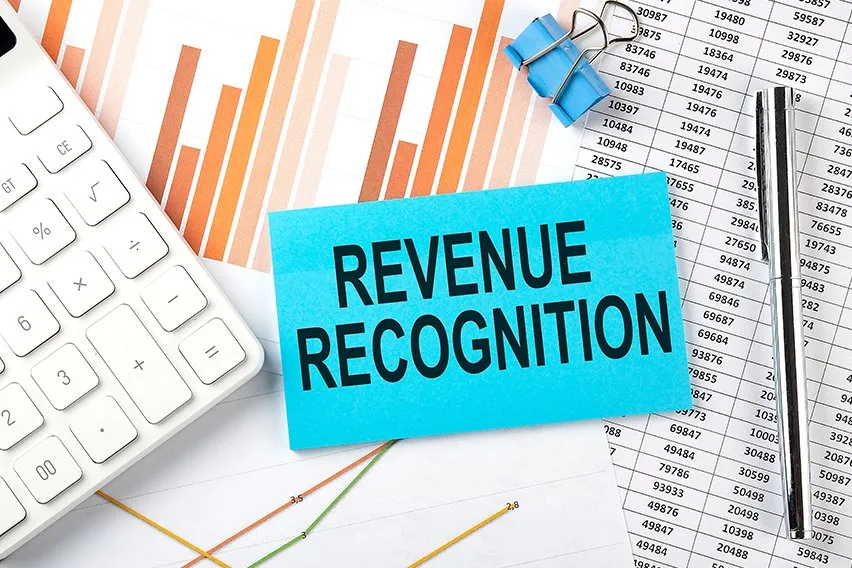Revenue Recognition: Definition, Principles & Example Guide

Every business is going to operate differently compared to others. Some might focus more on things like product placement and advertising costs. Others might choose to focus on set-up costs, operating costs or financial reporting.
The point is that regardless of the type of business that you do, growing revenue is critical to success. There are lots of accounting principles that get used for different business reasons. And one of those accounting principles is revenue recognition.
So, what exactly is revenue recognition and why does it matter? Let’s take a closer look.
Here’s What We’ll Cover:
Conditions for Revenue Recognition
Why Does Revenue Recognition Matter?
What Are the Principles of Revenue Recognition?
What Is Revenue Recognition?
Do you know how much revenue your business earned in the past month? What about the past 6 months? Do you generate any revenue from contracts with customers? Answering those questions is easier for some businesses compared to others. For example, a retail business generates sales figures to forecast future demand.
But what if you’re a contractor who gets paid up-front or you have a subscription-based business? Revenue recognition is an accounting principle that determines when you have earned revenue.
To help break it down, you can think of it in two different ways. The first is if you use the cash basis of accounting for your business. The cash basis of accounting breaks down your revenue when the actual cash that you have.

The second is a business that uses accrual basis accounting. This recognizes revenue only when it has been earned. This is why there are Generally Accepted Accounting Principles, or GAAP. These are rules for when and how you can recognize revenue. They also let you know how to make sure you report it correctly on income statements.
Revenue recognition identifies conditions where revenue is recognized and how to account for it. Revenue is usually recognized after some type of critical event has happened. This is because the final dollar amount is much easier to measure against the business.
Conditions for Revenue Recognition
In order for revenue to get recognized, there are some conditions that first need to be met.
- Any risks or rewards of ownership need to have gotten transferred from the seller to the buyer
- After this, the seller loses any control over the goods sold
- There is a collection of payment for the goods or services and it’s reasonably assured
- The total amount of revenue can get reasonably measured
- The total costs of revenue can get reasonably measured
The first two conditions get referred to as performance conditions. This is when the seller has finished what was expected and is then entitled to payment. The third condition gets referred to as collectability. This is when the seller must have a reasonable expectation that they will get paid for their performance.
The final two conditions get referred to as measurability. Due to accounting guidelines, the seller needs to be able to match any revenues to any expenses. So, both revenues and expenses need to be able to get reasonably measured.
Why Does Revenue Recognition Matter?
Revenue is at the core of all your business processes and overall performance. Your business wouldn’t be able to survive, let alone become profitable, without sales. And since sales drive revenue, regulators recognized how tempting it can be to expand what might qualify as revenue.
This is especially true when revenue isn’t collected until after work gets completed. For example, an attorney will charge a client based on billable hours. They will then submit an invoice to the client after the work gets completed.
Accurately accounting for revenue can sometimes get complicated for any number of reasons. There can be situations where there are exceptions to the revenue recognition principle.
The revenue recognition principle is one of the features of accrual accounting. It requires revenue to get recognized within the same income statement. And within the same period that revenue is realized. It doesn’t have to necessarily be when cash is actually received.
What Are the Principles of Revenue Recognition?
The Financial Accounting Standards Board (FASB) and the International Accounting Standards Board (IASB) created the Accounting Standards Codification (ASC) 606. The ASC 606 sets a foundation and a framework for recognizing revenue. Previously, guidance was industry-specific which resulted in a system of broken policies.
The new standard is industry-neutral and much more transparent for businesses to understand. Basically, it helps improve the comparability of financial statements. And it does this by standardizing the practices within multiple different industries.
With the revenue recognition principle, there are five steps that you will need to take first.
- Identify and confirm the details of the contract with the customer
- Identify and confirm any contractual obligations, such as performance requirements
- Determine any consideration or the amount of price for the transaction
- Allocate the proper amount of consideration to the outlined contractual obligation
- Recognize revenue after any performance obligations get satisfied
Examples of Revenue Recognition
It can be pretty simple, but depending on the type of business model you have it could be a bit more challenging. For example, if you primarily sell footwear, then it’s easier to recognize revenue. But what if you operate based on a subscription-based model or you’re a contractor? In those instances there could be a little more that goes into it.
Let’s take a look at a few examples.
The first example is if you have a subscription service.
Imagine that you started your own sneaker club subscription service. You called it Company A’s Class of Customer. Let’s say your customers pay $300 for annual membership services up-front. And each month they receive a custom pair of sneakers.
When do you think you would recognize the revenue?
In this case, you might only recognize $25 of revenue each month instead of the whole $300. Why? Well, just because a customer paid you $300 doesn’t mean that you have earned that entire $300 yet. Another customer might cancel their subscription before the end of the contract. This means that you might have to start accounting for membership refunds.
What about if you’re a contractor? Does it work the same way?
Basically, yes it works the same way. Let’s pretend that you operate a freelance accounting service, called AccountKing. Over the years, you have built up an excellent client list and have grown exponentially. Plus, you have a highly successful podcast with tips for small business owners.
One day you receive a call from a company that wants to take out $12,000 worth of ads on your podcast over four months. When do you think you would recognize the revenue?
Similar to a subscription-based service, the best way to recognize revenue is to split it up. This way you are only recognizing revenue after the ads have run each month. So, you would recognize around $3,000 in revenue each of those four months.

Key Takeaways
There are so many moving parts to a business and each one plays an important role. But, revenue is at the core of successful business performance. Revenue recognition identifies conditions where revenue is generated. It also lets you know how to account for it.
Revenue recognition is a Generally Accepted Accounting Principle and there are a few conditions to know. Basically, any risks or rewards of ownership need to get transferred from the seller to the buyer.
The seller loses any control over the goods and there is a collection of payment. The collection of payment gets assured and the total amount of revenue can get measured.
The FASB and the IASB created the Accounting Standards Codification (ASC) 606. This is a framework for understanding and recognizing revenue. Before this, any guidance that was in place was generally industry-specific. Now. The new revenue recognition standard is industry-neutral.
Why does this matter? Because it helps improve the comparability of financial statements. And it does this by standardizing the entire list of revenue recognition practices. In order to satisfy the revenue recognition principle, there are five steps that need to be met first.
- Identify the details of the customer contract
- Identify any obligations that are outlined in the customer contract
- Determine the final transaction price
- Allocate the right amount for the transaction price according to performance obligations
- Recognize revenue once all performance obligations have been met
Your business depends on sales to stay profitable and keep its doors open. The new revenue recognition framework helps you report revenue properly on income statements. It’s a feature of accrual accounting and it requires revenue to get recognized within the same income statement in the same time period.
Did you enjoy reading this guide? Head over to our resource hub for more great content!
RELATED ARTICLES


 Distribution Management: Definition & Advantages
Distribution Management: Definition & Advantages What Is Subscription Billing? 6 Software To Manage Billing
What Is Subscription Billing? 6 Software To Manage Billing What Is a Partner Program? A Guide to Building an Ecosystem
What Is a Partner Program? A Guide to Building an Ecosystem What Are Performance Objectives? 5 Top Objectives
What Are Performance Objectives? 5 Top Objectives What Is Outbound Logistics: Strategies & Performance
What Is Outbound Logistics: Strategies & Performance Self-Employed Vs Employee: What’s the Difference?
Self-Employed Vs Employee: What’s the Difference?